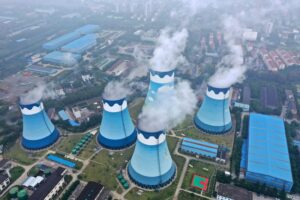As part of the UN climate process, developed countries have been encouraged to donate “international climate finance” to help developing countries cut emissions and prepare for climate disasters.
There has been a significant debate around whether China, as an increasingly wealthy developing country, should also contribute.
China’s stance remains controversial. The country did not make a pledge to the “loss-and-damage fund” established at COP28, but has provided alternative climate funding through its South-South Climate Cooperation Fund and the Belt and Road Initiative (BRI).
Ahead of next week’s Bonn conference – where delegates are expected to negotiate climate finance – Carbon Brief has interviewed Li Shuo, head of the China climate hub at the Asia Society Policy Institute (ASPI), on the prospects for China’s climate contribution.
Through talking to various climate experts, including Chinese government officials and consultants, Li examines the motives behind China’s current policy and strategy.
He tells Carbon Brief that focusing on China’s ability to encourage investment that increases use of affordable low-carbon energy solutions worldwide could be one way to encourage the nation to play a greater role in international climate finance.
The wide-ranging discussion with Li covered possible outcomes from this year’s COP29, prospects for US-China alignment, barriers and incentives for China to increase its financial contribution, and more:
- On the climate finance debate: “This is indeed one of the most controversial issues…that sees very strong division between the global south and the global north.”
- On China’s dominance of low carbon technology: “I actually hope this could be one solution to the…NCQG [new collective quantified goal] question…It could be a solution based on which we can find a path forward.”
- On EU and US concerns: “I doubt the NCQG will ever be as explicit as China committing to support developing countries to buy China-made products…The decision will be made in more general terms; general enough to not agitate the US and the EU.”
- On improving the BRI as a climate finance mechanism: “The question is what role can China play to facilitate a better environment for its own engagement… That role will increasingly require China to engage…with the policy framework of those recipient countries.”
- On ‘inviting’ negotiation strategies: “Messages that are crafted in a more inviting way will probably work better…If your framing is ‘China needs to pay’, or ‘we believe China is ready’ or ‘China is responsible’, then I think politically this will become very difficult.”
- On multilateral cooperation: “[Our research has looked at] whether trilateral cooperation would be possible – if not solving all the problems, at least a few demonstration projects that will convey a political signal that we’re all in…There could be areas where China and other traditional donor countries can complement each other.”
- On US-China tensions: “[COP29] is probably the best recipe for huge tension between the US and China. Given the agenda set for this COP: it is finance, right? …This one is particularly controversial. If one side or both sides want to weaponise this issue, they can find all the ways to weaponise it and blow up the COP.”
- On the new US and Chinese climate envoys’ relationship: “The two envoys are, I think, also committed to learn from what has served this relationship in the past, including by building a personal relationship.”
- On future US-China climate cooperation: “This dynamic…also puts the bilateral climate relationship firmly into the pattern of the rest of the bilateral relationship…when they meet, there is normally a set of standard talking points without too many substantive agreements, let alone progress.”
- On the need for political courage: “[Climate change] is a time-bound, global, environmental crisis that requires real solutions…We still haven’t seen the political courage to set this issue aside.”
The interview is reproduced in full, below, with some editing for clarification. An abridged version of the transcript has been published in China Briefing, Carbon Brief’s fortnightly email newsletter focusing on climate and energy developments relating to China. (Sign up for free.)
Carbon Brief: At the upcoming COP29 climate talks [in Baku in November], countries will be negotiating a new climate finance target to replace the current $100bn goal for developed countries. As the world’s biggest emitter, China is facing growing calls to start contributing. How is China responding to these calls?
Li Shuo: I think we are expecting a pretty heated debate at COP29. This is indeed one of the most controversial issues…that sees very strong division between the global south and the global north. And, of course, China is in this unique position: it is still firmly in the developing country camp, but, at the same time, it has become one of the largest economies and the largest emitters in the world. So with that, you know, there’s this argument that China should shoulder more responsibility internationally, including by providing future climate finance.
The geopolitical environment is definitely not helping that transition: the tension between China and the west, and also this long-standing deficit on the part of the developed countries to deliver what they have promised. In addition to that, China’s domestic political and economic situation – let’s just say, it’s not at a particularly helpful moment for that transition to happen, [with] the domestic economic slowdown and so on. So we see a lot of risk factors. There is a critical need for other countries and China to work out, to align, ahead of COP29 on this issue. I think the next few months will be very important.
CB: We have seen the US president Joe Biden ramp up tariffs across China’s “new three” types – electric vehicles, solar products and lithium-ion batteries. Some in China might argue that they are contributing to the energy transition by providing affordable, clean energy technology and, therefore, they shouldn’t be pressured to scale up climate finance. Do you think that this could be one of the arguments made by the Chinese negotiators against greater ambition at COP29?
LS: Well, I actually hope this could be one solution to the $100bn – or $1tn – NCQG [new collective quantified goal] question. I actually genuinely see that it could be a solution based on which we can find a path forward for China, but also the rest of the world.
The reason I say this is, indeed, as you outlined, in addition to China’s emission portfolio, the country also happens to be the biggest solution provider when it comes to low-carbon products. Of course, there are increasing political controversies around China’s position in this regard, in particular between the US and China. But, I think, if you were China, what you want to achieve is, of course, to make sure that you can continue to sell those low-carbon solutions to the rest of the world.
So I would argue it actually works in China’s self-interest to make sure that they can facilitate the deployment of renewable energy in the global south. And, that way, I think it helps address the geopolitical problem, the so-called overcapacity [problem]. I mean, they realise that overcapacity always has two sides: oversupply and under-deployment. If you can tackle the same problem from the under-deployment side, that’s helping you geopolitically, but that’s also helping your businesses, that’s helping your companies in real ways. How do you do that? I think a role to provide finance or facilitate investment in developing countries is the way to achieve that. And if China can play a role in this regard, at the bare minimum, it is helping its own companies.
CB: Do you think that that would be politically viable? It would require the EU and the US signing off on saying: “Even though we’re launching investigations and tariffs into Chinese companies domestically, we support China’s global deployment of the ‘new three’ types.”
LS: I doubt it will be. I mean, if you’re talking about the NCQG package, I doubt the NCQG will ever be as explicit as China committing to support developing countries to buy China-made products…The decision will be made in more general terms; general enough to not agitate the US and the EU. In my mind, of course the NCQG discussion is still an ongoing one, but you might be familiar with this “onion” [structure] approach, a kind of multi-layer package. You have a core: public international finance. The controversial issue there is you will have a number, but who will be accountable for that number? That’s one thing. Then the second [layer] might be some sort of investment facilitation, if you will, and that’s where I think China can play a role.
I think it is in that layer that I feel like this is actually the interesting ongoing geopolitical development. You can actually make a stronger argument [now] than before to convince China that they should really play a role in that second layer, because it is helping its trade and investment facilitation, in essence. It is helping them to sell to the rest of the world. So they should be willing to play a role there. As long as that provision is not framed as sensitive to the West, I think there is an area where the two sides can converge. Because at the end of the day, developed countries are also trying to gain more money, so that they can be a little bit less liable on the public international finance side. So there might be a point of convergence.
CB: While often not widely recognised, China has contributed climate funding via both its “South-South Climate Cooperation Fund” and the Belt and Road Initiative (BRI). How significant is this funding?
LS: I think here, the number is even secondary – to both China and its international counterparts. I think the most important point here is to realise that China can actually contribute internationally to the decarbonisation agenda, and China is already doing so. So the political question then is not whether China will do it or not, but how can we make sure [it plays] a larger role? I think that is the key political point…You have a base to build on, we’re not talking about ‘ground zero’.
But when you look at the details of what China has been doing, I think, number one, there has been real investment and financial support to the global south, primarily through the BRI. The BRI now is going into a second phase which will [have more emphasis on] quality and sustainability. I hope that actually will help China to do more to help developing countries to scale up their renewable energy development. I think the second part that China has been doing is more kind of public finance – south-south cooperation and so on. There, we didn’t do the number crunching, but if you look at [climate thinktank] E3G‘s report, their argument is that there has been a gap – a huge gap – between what China has committed to in the past and what it has actually delivered.
In addition to that, we understand that the existing support and projects are done on a rather ad-hoc basis, lack a coherent strategy and are also constrained by various domestic policies. One example that I can give you – and this is well known as part of China’s south-south climate support – [is the] domestic procurement policies dictate that [what are] essentially development aid projects can only rely on Chinese-made products, which is fine, but a lot of times not services. So it has to be hardware – it has to be hardware – [which is donated] a lot of the time, not know-how. So that’s a problem. You would think that’s a problem that China can easily solve. And that’s also our argument. When we draw attention to the non-monetary actions needed, this is one of them – to reform domestic policies, so that it better facilitates effective action. I can also say, as a result of the domestic procurement policy, you see mostly solar water heaters, roadside solar-powered lights and quite a few satellites – literally satellites – being donated to the global south. These are the result of the rather outdated domestic procurement policies. So that needs to be reformed as well.
CB: Over the course of your research at ASPI on climate finance, you’ve spoken to various Chinese stakeholders – government officials, non-government organisations and industry participants. Do you see an increasing internal alignment to try and unify this kind of domestic policy-making process, in procurement or in other climate financing issues, or is there still a lot of fragmentation?
LS: The answer is no, there’s still a lot of fragmentation. I think the tricky situation that we have now is, if you go back to the early 2010s, the country was on the rise and there was a “go out” spirit, very much accelerated by the BRI. And, as a result of that, you have the “hundred flowers blooming” [bǎi huā qí fàng 百花齐放, which here means various industries growing successfully], right? Different agencies are all handling some sort of overseas project, be they aid-, investment- or trade-related. So you end up with an unavoidable fragmentation. What has happened since a few years ago is that, all of a sudden, there is a declining political appetite – or ability – to go as much out as [there was] a decade ago. But you still have the various channels. So that’s where we are: a shrinking political will or economic ability, but still a very fragmented bureaucratic picture.
So how do we go from here? I think the country – and this is a bit of a side-note – I think the country is in a bit of a “soul-searching” mode. On one hand, dealing with lack of political will or economic capacity. On the other hand, there is still a deeply fragmented bureaucratic landscape. It’s a bit hard to see how the situation will improve in the very near term. Ideally, there needs to be a high-level signal to call for a coherent strategy, but I don’t think that signal will happen anytime soon. I also think – and this is also just a side-note – bureaucratic fragmentation is a long-standing consistent theme in Chinese political culture. It even goes beyond the specific issue that we’re talking about in this area of development aid. If you look at other areas, it’s a similar situation. Fragmentation is the rule, not the exception.
CB: What do you think could be some practical short-term changes to improve the BRI as a vehicle for climate finance?
LS: I think this is increasingly something many organisations are looking at: namely, the Chinese role in helping developing countries. I think primarily – let’s just use southeast Asian countries as an example, looking at how to help southeast Asian countries to scale up their renewable energy deployment. The complicating factor there is it is not a one-party exercise. It’s not as easy as saying China has the equipment, it has the political will to sell the equipment, and the equipment will somehow be installed in the Philippines or Indonesia. The recipient country also plays a very important role providing the policy framework, the political economic environment in which those projects will be developed. There are still many gaps in those environments. It takes two to tango.
The question is what role can China play to facilitate a better environment for its own engagement with those countries. And that role will increasingly require China to engage, not only on the commercial level – providing the hardware, investment or construction – but also engage with the policy framework of those recipient countries. That’s going to take some time, but I think that’s increasingly where China needs to go. The good news is, at a very high level, all these countries have committed to various decarbonisation courses, and we have committed too, also, at COP last year, to the tripling of renewable energy. So how do we operationalise those very high-level visions at the ground level in a country like Indonesia, and what’s China’s role in it?
CB: This question might lean towards over-generalisation, but wouldn’t a counter-argument be that China is an attractive investment partner precisely because it doesn’t [engage with the policy framework of] recipient countries? Is there an incentive from the investment recipient’s side to make China have these higher standards?
LS: Again, it’s a two-way tango. But I think the good news is, number one, on the Chinese side – at least when it comes to the energy sector – China has already committed to not support coal-fired power plants. So, in a way China is going there without principles, without any kind of pre-judgments, but, in a way, China has already made a very strong rule for itself with “no coal”. And this has been largely implemented – with a few exceptions here and there, but we’re certainly not talking about what happened in the 2010s: 10 coal-fired power plants here in Indonesia, [and] on another island in Indonesia five more. That’s not where we are.
So, in a way, that question has really been partly solved, by a self-imposed rule from China and we should give them credit for that. They’re trying to move to the “greener” side. But, indeed, how do we also accelerate the necessary policy framework on the part of developing countries? This is a critical area.
I would just say we’re still quite new in this exercise. China only announced not to support coal [three] years ago. We’ve only made big strides when it comes to the global energy transition and the big visions at COP28 half a year ago. It takes a long time for domestic policy reforms in countries, such as the Philippines and Indonesia. There are also physical infrastructure constraints in those countries. So it takes time for the two sides to work things out. But I think the general mission, or the general direction, is there. It’s not a “whether” question, but a “how” question: how can China accelerate its cooperation with Indonesia, and vice versa.
CB: How do you think that requests for China to contribute to climate finance, be they made by Western countries or by potential [recipient] countries, could be more successful? And, then, which countries do you think could be the most effective and the most amenable partners?
LS: When you talk about UNFCCC climate finance, it is an intrinsically more political debate. The core of the question is: how does China see itself in relation to the rest of the world, and in relation to other traditional donor developed countries, right? Does it see itself graduating to shoulder the same, or similar, responsibilities? Or does it see itself as still not there yet? And how will China think about the lack of delivery of the traditional donor countries [of the $100bn climate finance goal]. This is the core of the question.
I think, going forward, messages that are crafted in a more inviting way will probably work better with China. But that’s precisely the challenge. The political environment that we have will almost prevent that conversation from happening. That’s why the NCQG donor base question will be such a difficult one. I think, in an ideal world, a facilitating, inviting political environment, is what you want to create to facilitate higher aspiration on the Chinese part over time.
CB: Could you explain what you mean by “inviting”?
LS: I think there are two examples. One is simply how we talk about this issue, right?…If your framing is ‘China needs to pay’, or ‘we believe China is ready’ or ‘China is responsible’, then I think politically this will become very difficult for China. Because a lot of the framing – even just enlarging the donor base, that phrase – if you think about it, it assumes kind of a moral high ground. Somebody is saying we need to enlarge the donor base: who is that somebody? That is somebody who thinks they occupy a moral high ground. That framing also implies a legal argument – there’s a legal argument to actually formally enlarge the donor base, which I think China will not agree with.
Enlarging the donor base also carries this undertone that “we want more people to pay so that we can pay less”, if you think about it. It’s very – given the current geopolitical environment – it’s very easily perceived as just an extension of the political tension between China and the west, an extension to the climate finance field. So, given all these reasons, we just need to find a different way, a better way, to talk about this issue. We’re not trying to shy away from this issue, but [we need] a better way to talk about it.
The other example that I can give you is not narrative or framing, but concrete project-level action. [Our research has looked at] whether trilateral cooperation would be possible – if not solving all the problems, at least a few demonstration projects that will convey a political signal that we’re all in. This is not about shying away from our responsibility, but it’s all hands on deck: everybody trying to play to their strengths and play a role. What we mean by trilateral cooperation is one side, of course, is the recipient country – climate-vulnerable countries – and China and traditional donor countries. We do believe there could be areas where China and other traditional donor countries can complement each other. They need to work out the specific areas where they share synergy.
From our conversation with practitioners, I think they all realise that this is a very good idea, there is a political will to embrace that model. But when it comes to the practical details, I can give you one example: if you want to play into the strengths of China’s ability to deliver low-carbon products, and it strengths to be able to get those projects deployed very fast, and you want to tap into the financial resources that developed countries have – you could easily imagine that this will not work for developed countries, because they are essentially channelling their taxpayer money to buy China-made products. That’s a political no-go. [Despite] the desire [for cooperation] and everybody seeing the benefit of trilateral cooperation, I also wouldn’t want to underestimate the practical challenges – there are a lot of constraints, a lot of them imposed by the current geopolitical environment.
CB: Something that struck me, whilst I was looking more into US-China moves on climate finance, is that the South-South Climate Cooperation Fund was actually announced by Xi during a press conference at the White House in 2015. How would you say that conditions in the US-China dynamic have changed since then? And is there a possibility we could ever get back to that 2015 cooperation?
LS: I had the same lightbulb moment when I reviewed what happened in 2015. The two countries actually came together on finance and they actually announced [funds worth] the same amount of money to developing countries. What signal does that send? That signal says: “Hey, China believes it is shouldering the same responsibility as the US when it comes to supporting the global south”. That was what happened nearly 10 years ago. That’s striking if you think about it now. We’re in a very different time now.
I think the G2 (the US and China) angle is critical because, if you think about it, for the last couple of COPs, I think this one [COP29] is probably the best recipe for huge tension between the US and China. Given the agenda set for this COP: it is finance, right? I’m not saying for the last couple of COPs there were no controversial issues between the G2, but this one is particularly controversial. If one side or both sides want to weaponise this issue, they can find all the ways to weaponise it and blow up the COP.
This year we are also facing a unique challenge, which is we’re in a US election year, and we also have two [new] climate envoys on both sides. So [this is] different from the last couple of years, when at this point in the year you probably already knew that [former climate envoys] John Kerry and Xie Zhenhua are working on something, trying to resolve their differences before the COP. We don’t have clarity on that at this point in time.
In our view, the two sides will definitely need to find a minimum level of alignment on the NCQG question, on the donor-base question. That’s a necessary condition for the COP to be a smooth-sailing one. Will they be able to do that? I think that’s the real question. I can’t imagine a COP which features the US sitting on one side of the table and the Chinese sitting on the far other side. That will make for a very contentious COP. I hope that they get this message that it’s actually also in their interest to find alignment in advance. We’re also – to add one more thing – dealing with a rather inexperienced COP president. So if you want to make the job easier for them, you’d want some big power alignment ahead of time.
CB: We’ve talked about big changes regarding the negotiation teams, the changes due to the fact the US election is coming up. But we’ve also seen significant changes in China’s economic situation, especially compared to 10 years ago. You interviewed various people on this impact, in particular. What are the barriers in their view to China scaling up current climate financing and future pledges?
LS: I think the economic challenges are high on people’s mind and, politically, it imposes a very strong mental barrier – I think we felt this very strongly in our conversations – mental barriers with our Chinese interlocutors, for an idea that would push them to do more internationally. It’s just very difficult to achieve that now.
That’s the reality that we need to deal with. That is also why our sense is that there are indeed very real and challenging barriers for China to scale up its international climate finance in the near term. I don’t think we can be naive about it. But, that said, we also tried to find ways to ensure that [China] will actually be able to do more and achieve more in practice. That’s why [ASPI] also made the suggestion that we can drive an even stronger emphasis on sustainability in China’s existing international infrastructure initiatives – such as the BRI. I think that’s a pragmatic way to actually ensure more finances go into the low-carbon dimension.
And I also think – one more piece of advice here – is that people who are working at the international level when it comes to climate finance tend to be COP-oriented. People’s timeframes when thinking about their strategy is on a yearly basis. But I think we also need to realise that this is a multi-year exercise. There are certain political conditions that you will need to build over time to convince China or facilitate China to do more.
So what are the multi-year investments? What are the seeds that you can plant now to cultivate over time? That’s the background against which we make recommendations such as…more sharing of knowledge and experience from traditional donor countries to China, on how they have managed their climate aid – what’s the right institutional setup; how they developed their strategy; how were projects selected and developed; and their experience working with recipient countries…You guys are familiar with, for example, the ETS [China’s emissions trading system], right? It’s a huge undertaking to build up the technical capacity in China – there has been a decade of capacity-building support, from the European side primarily. I would say China’s development of international aid is an exercise on a similar scale, if not even larger.
CB: Recently, the two new climate envoys, Liu and Podesta, met in the US. Can you share any signals from their meeting about how US-China interactions might look – not just on climate finance, but across the board?
LS: I think I’ll just say three things. Number one: I think this visit proves that there is still willingness between the two countries to engage with each other, there is still a strong commitment to implement what they agreed last year in the Sunnylands agreement. Liu’s visit in DC, we should note, is the meeting of the bilateral working group that the Sunnylands agreement re-established. So this is a continuation and the implementation section. As you saw in the readout, there was also progress made during his visit in DC. So that’s message number one. I should also add that the two envoys are, I think, also committed to learn from what has served this relationship in the past, including by building a personal relationship with each other. They had a working lunch and then reportedly John Podesta also hosted Liu and part of his team at his house for dinner.
The second message is that, despite all of the shared commitment to implement and to continue their engagement, there are many differences and contentious points. Many of those disagreements are structural – disagreements for which it is very difficult to see any near-term solutions or breakthroughs. The US concerns over China’s energy sector and the continued investment in coal, for example. The gap between the US’s expectations on China’s NDC [nationally determined contributions] and what China is willing to commit to. And, on the Chinese side, their scepticism about the US’s ability to deliver what it has promised, both when it comes to climate emission reduction targets, and also climate finance. And, added on top of that, of course, is the trade issue. So there are still many disagreements.
I think this dynamic, this disagreement, also puts the bilateral climate relationship firmly into the pattern of the rest of the bilateral relationship. What I mean by this is: if you look at ongoing bilateral dialogues on finance, trade and many other issues, the pattern is very clear: the two sides are committed to engage with each other; keep communication channels open; they will meet, either in China, or in the US, or in third countries; and, when they meet, there is normally a set of standard talking points without too many substantive agreements, let alone progress.
I think this is a dangerous pattern, if not for other issues, at least for climate change – because this issue is a time-bound, global, environmental crisis that requires real solutions and real progress between the two countries. And we still haven’t seen the political courage to set this issue aside so that, in an overall competitive relationship, progress can be made on certain issues: issues that are in the shared interests of both countries, but also of the rest of the world. We haven’t seen the political courage to allow that to happen and allow progress in a small number of issues. So that, I think, is very concerning. But, to be honest with you, I think this will be the pattern for the rest of the year, in the run-up to the [US] election.
That brings me to my third point, which is looking ahead. If some of the structural disagreements cannot be addressed between the two countries, there are at least a few issues on the multilateral agenda – in particular, climate finance – that would require the two countries to work together to bridge their differences and to find minimum levels of alignment ahead of the COP. The question is will they be able to do that? I am not entirely sure what signals this trip has sent – this is something that I think will require all of our attention. I think, fundamentally, on climate finance, it works in both countries’ interest if they can find alignment before the COP.
CB: Great, thank you.
LS: No worries, anytime.
The post Interview: China’s position on ‘international climate finance’ ahead of COP29 appeared first on Carbon Brief.
Interview: China’s position on ‘international climate finance’ ahead of COP29
Climate Change
Guest post: Why China is still building new coal – and when it might stop
Last year, China started construction on an estimated 95 gigawatts (GW) of new coal power capacity, enough to power the entire UK twice over.
It accounted for 93% of new global coal-power construction in 2024.
The boom appears to contradict China’s climate commitments and its pledge to “strictly control” new coal power.
The fact that China already has significant underused coal power capacity and is adding enough clean energy to cover rising electricity demand also calls the necessity of the buildout into question.
Furthermore, so much new coal capacity provides an easy counterargument for claims that China is serious about the energy transition.
Did China really need more coal power?
And now that it is here, do all these brand-new power plants mean China’s greenhouse gas emissions will remain elevated for longer?
This article addresses four common talking points surrounding China’s ongoing coal-power expansion, explaining how and why the current wave of new projects might come to an end.
New coal is not needed for energy security
The explanation for China’s recent coal boom lies in a combination of policy priorities, institutional incentives and system-level mismatches, with origins in the widespread power shortages China experienced in the early 2020s.
In 2021, a “mismatch” between the price of coal and the government-set price of coal-fired power incentivised coal-fired power plants to cut generation. Furthermore, power shortages in 2020 and 2022 revealed issues of inflexible grid management and limited availability of power plants, when demand spiked due to extreme weather and elevated energy-intensive economic activity, compounded by coal shortages, reduced hydro output and insufficient imported electricity import.
Following this, energy security became a top priority for the central government. Local governments responded by approving new coal-power projects as a form of insurance against future outages.
Yet, on paper, China had – and still has – more than enough “dispatchable” resources to meet even the highest demand peaks. (Dispatchable sources include coal, gas, nuclear and hydropower.) It also has more than enough underutilised coal-power capacity to meet potential demand growth.
A bigger factor behind the shortages was grid inflexibility. During both the 2020 power crisis in north-east China and the 2022 shortage in Sichuan, affected provinces continued to export electricity while experiencing local shortages.
A lack of coordination between provinces and inflexible market mechanisms governing the “dispatch” of power plants – the instructions to adjust generation up or down – meant that existing resources could not be fully utilised.
Nevertheless, with coal power plants cheap to build and quick to gain approval, many provinces saw them as a reliable way to reassure policymakers, balance local grids and support industry interests, regardless of whether the plants would end up being economically viable or frequently used.
China’s average utilisation rate of coal power plants in 2024 was around 50%, meaning total coal-fired electricity generation could rise substantially without the need for any new capacity.
At the same time as adding new coal, the Chinese government also addressed energy security through improvements to grid operation and market reforms, as well as building more storage.
The country added dozens of gigawatts of battery storage, accelerated pumped hydro projects and improved trading linkages between electricity markets in different provinces.
Though these investments could have gone further, they have already helped avoid blackouts during recent summers – when few of the newly-permitted coal power plants had come online. As such, it is not clear that the new coal plants were needed to guarantee security of supply in the first place.
President Xi Jinping has stated that “energy security depends on developing new energy” – using the Chinese term for renewables excluding hydropower and sometimes including nuclear. According to the International Energy Agency, in the long run, resilience will come not from overbuilding coal, but from modernising China’s power system.
New coal power plants do not mean more coal use and higher emissions
It may seem intuitive to imagine that if a country is building new coal power plants, it will automatically burn more coal and increase its emissions.
But adding capacity does not necessarily translate into higher generation or emissions, particularly while the growth of clean energy is still accelerating.
Coal power generation plays a residual role in China’s power system, filling the gap between the power generated from clean energy sources – such as wind, solar, hydro and nuclear – and total electricity demand. As clean-energy generation is growing rapidly, the space left for coal to fill is shrinking.
From December 2024, coal power generation declined for five straight months before ticking up slightly in May and June, mainly to offset weaker hydropower generation due to drought. Coal power generation was flat overall in the second quarter of 2025.
The chart below shows growth in monthly power generation for coal and gas (grey), solar and wind (dark blue) and other low-carbon power sources (light blue).
This illustrates how the rise in wind and solar growth is squeezing the residual demand left for coal power, resulting in declining coal-power output during much of 2025 to date.
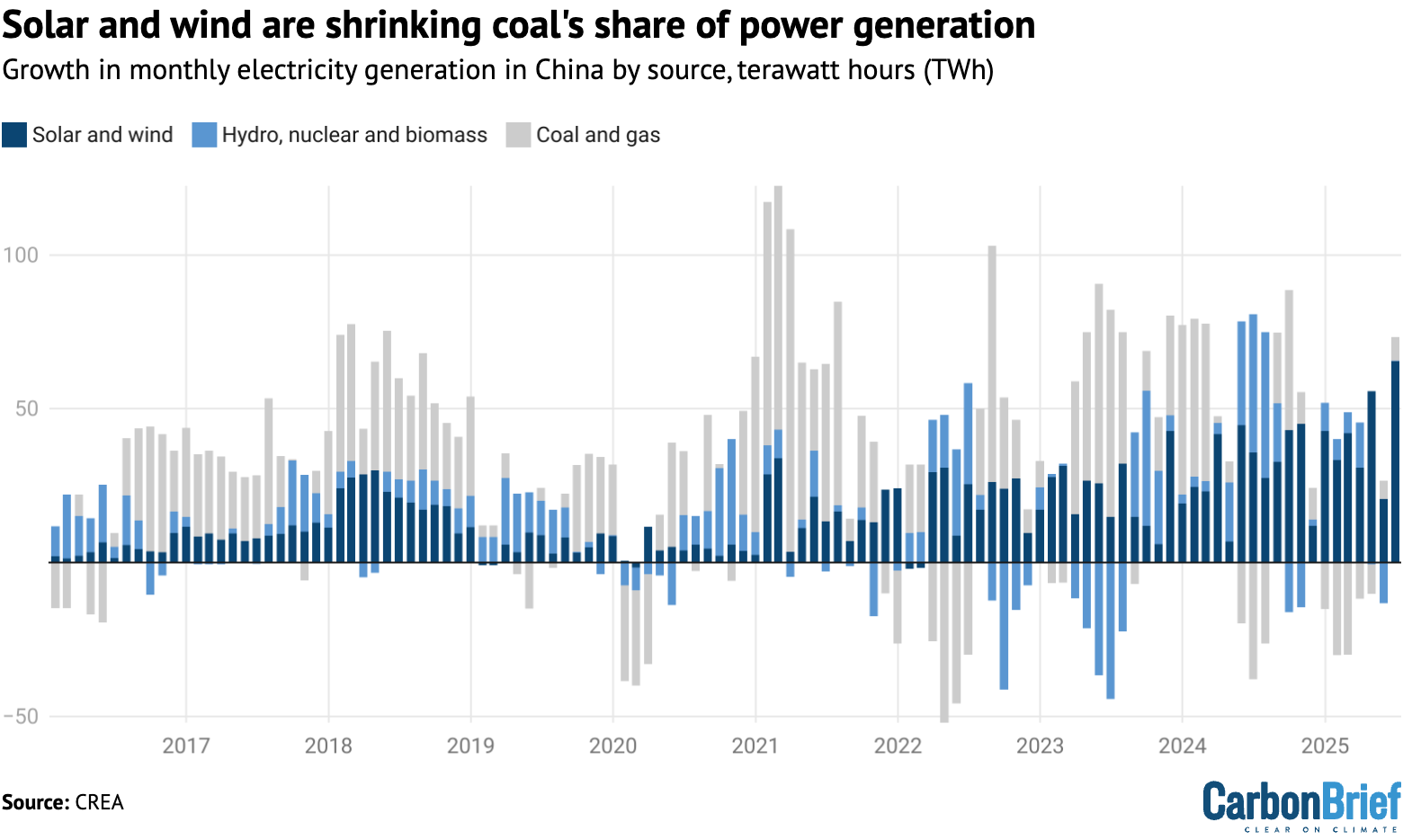
Another way to consider the impact of new coal-fired capacity is to test whether, in reality, it automatically leads to a rise in coal-fired electricity generation.
The top panel in the figure below shows the annual increase in coal power capacity on the horizontal axis, relative to the change in coal-power output on the vertical axis.
For example, in 2023, China added 47GW of new coal capacity and coal power output rose by 3.4TWh. In contrast, only 28GW was added in 2021, yet output still rose by 4.4TWh.
In other words, there is no correlation between the amount of new coal capacity and the change in electricity generation from coal, or the associated emissions, on an annual basis.
Indeed, the lower panel in the figure shows that larger additions of coal capacity are often followed by falling utilisation. This means that adding coal plants tends to mean that the coal fleet overall is simply used less often.
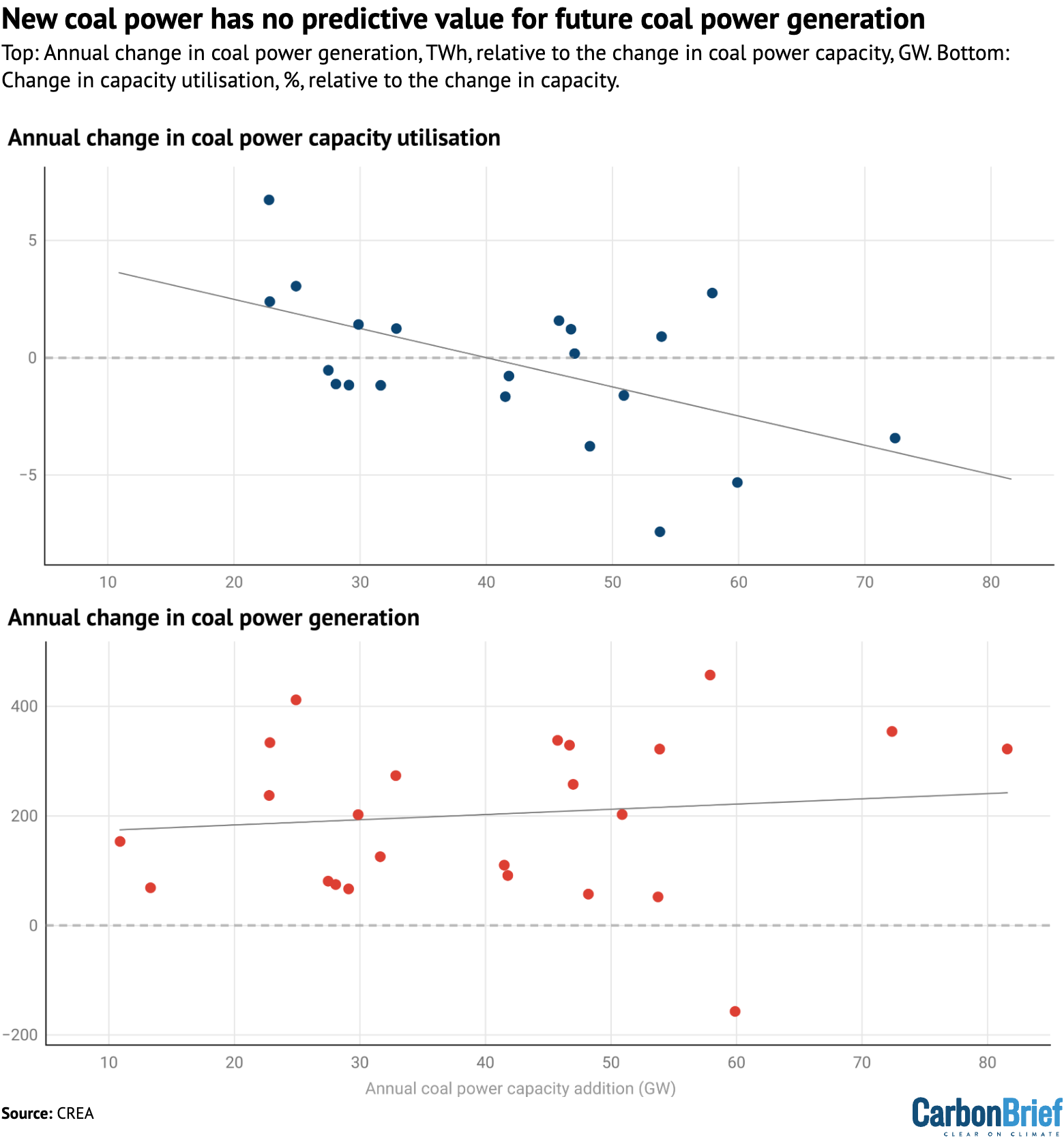
As such, while adding new coal plants might complicate the energy transition and may increase the risk of unnecessary greenhouse gas emissions, an increase in coal use is far from guaranteed.
If instead, clean energy is covering all new demand – as it has been recently – then building new coal plants simply means that the coal fleet will be increasingly underutilised, which poses a threat to plant profitability.
China is not unique in its approach to coal power
The dynamics behind last year’s surge in coal power project construction starts speak to the logic of China’s system, in which cost-efficiency is not always a central concern when ensuring that key problems are solved.
If a combination of three tools – coal power plants, storage and grid flexibility, in this case – can solve a problem more reliably than one alone, then China is likely to deploy all three, even at the risk of overcapacity.
This approach reflects not just a desire for reliability, but also deeper institutional dynamics that help to explain why coal power continues to be built.
But that does not mean that such a pattern is unique to China.
The figure below shows that, across 26 regions, a peak in coal-fired electricity generation (blue lines) almost always comes before coal power capacity (red) starts to decline.
Moreover, the data suggests that once there has been a peak, generation falls much more sharply than capacity, implying that remaining coal plants are kept on the system even as they are used increasingly infrequently.
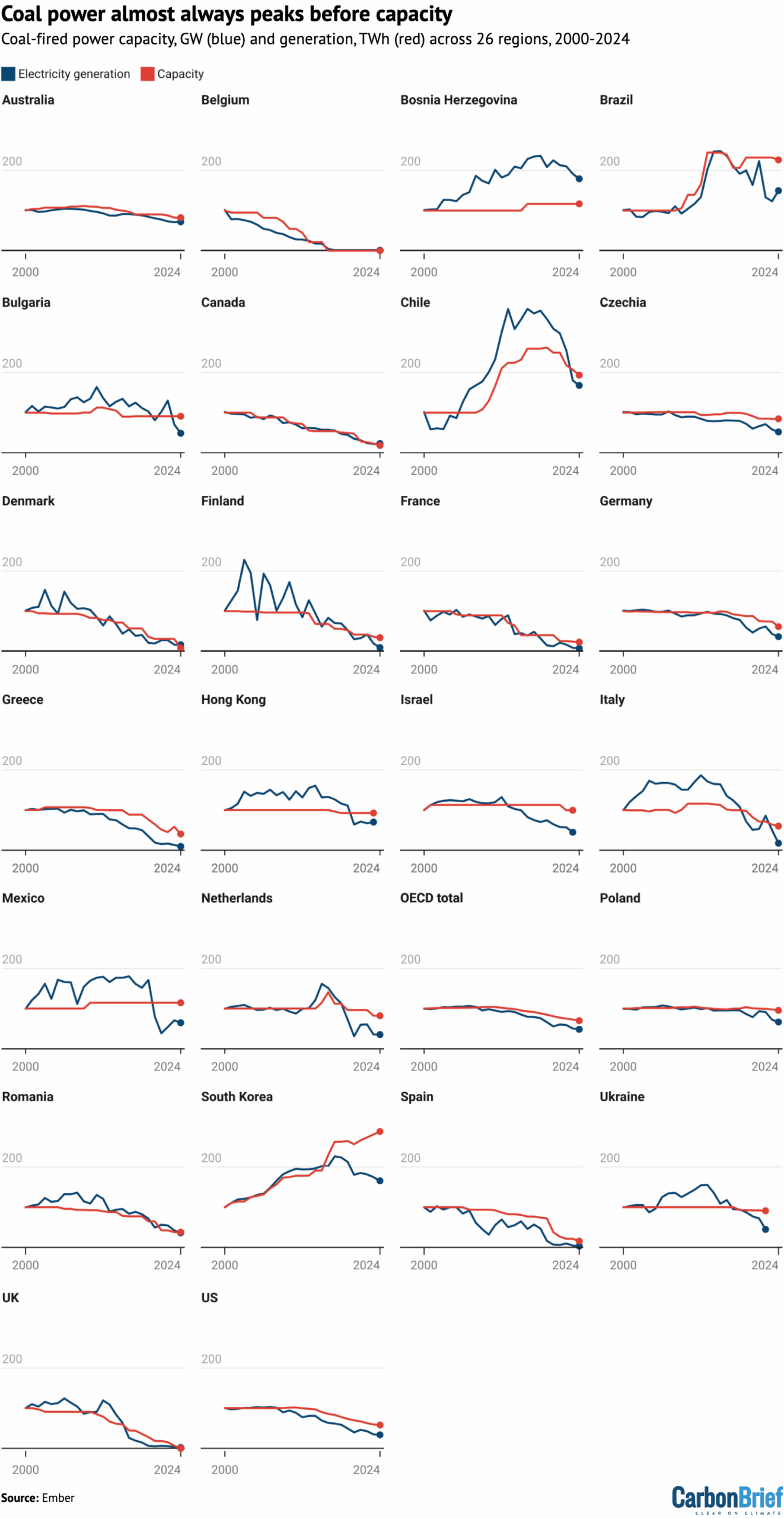
In most cases, what ultimately stopped new coal power projects in those countries was not a formal ban, but the market reality that they were no longer needed once lower-carbon technologies and efficiency gains began to cover demand growth.
Coal phase-out policies have tended to reinforce these shifts, rather than initiating them. In China, the same market signals are emerging: clean energy is now meeting all incremental demand and coal power generation has, as a result, started to decline.
Coal is not yet playing a flexible ‘supporting’ role
Since 2022, China’s energy policy has stated that new coal-power projects should serve a “supporting” or “regulating” role, helping integrate variable renewables and respond to demand fluctuations, rather than operating as always-on “baseload” generators.
More broadly, China’s energy strategy also calls for coal power to gradually shift away from a dominant baseload role toward a more flexible, supporting function.
These shifts have, however, mostly happened on paper. Coal power overall remains dominant in China’s power mix and largely inflexible in how it is dispatched.
The 2022 policy provided local governments with a new rationale for building coal power, but many of the new plants are still designed and operated as inflexible baseload units. Long-term contracts and guaranteed operating hours often support these plants to run frequently, undermining the idea that they are just backups.
Old coal plants also continue to operate under traditional baseload assumptions. Despite policies promoting retrofits to improve flexibility, coal power remains structurally rigid.
Technical limitations, long-term contracts and economic incentives continue to prevent meaningful change. Coal is unlikely to shift into the flexible supporting role that China says it wants without deeper reform to dispatch rules, pricing mechanisms and contract structures.
Despite all this, China is seeing a clear shift away from coal. Clean-energy installations have surged, while power demand growth has moderated.
As a result, coal power’s share in the electricity mix has steadily declined, dropping from around 73% in 2016 to 51% in June 2025. The chart below shows the monthly power generation share of coal (dark grey), gas (light grey), solar and wind (dark blue), and other low-carbon sources (light blue) from 2016 to the present.

When will the coal boom end?
About a decade ago, the end of China’s coal power expansion also looked near. Coal power plant utilisation declined sharply in the mid-2010s as overcapacity worsened. In response, the government began restricting new project approvals in 2016.
With new construction slowing and power demand rebounding, especially during and after the height of the Covid-19 pandemic, utilisation rates recovered. Not long after, power shortages kicked off the recent coal building spree.
Now, there are new signs that the coal power boom is approaching its end. Permitting is becoming more selective again in some regions, especially in eastern provinces where demand growth is slowing and clean energy is surging. Meanwhile, system flexibility is advancing.
Compared to the late 2010s, the current shift appears more structural. It is driven by the rapid expansion of clean energy, which increasingly eliminates the need for large-scale new coal power projects.
Still, the pace of change will depend on how quickly institutions adapt. If grid operators become confident that peak loads can reliably be met with renewables and flexible backup, the rationale for new coal power plants will weaken.
Equally important, entrenched interests at the provincial and corporate levels continue to push for new plants, not just as insurance, but as sources of investment, employment and revenue. Through long-term contracts and utilisation guarantees, this represents institutional lock-in that may delay the shift away from coal.
The next major turning point will come when coal power utilisation rates begin to fall more sharply and persistently. With large amounts of capacity set to come online in the next two years and clean energy steadily displacing coal in the power mix, a sharp drop in coal power plant utilisation appears likely.
Once this happens, the central government might be expected to step in through administrative capacity cuts – forcing the oldest plants to retire – just as it did during overcapacity campaigns in the steel, cement and coal sectors around 2016 and 2017.
In that sense, China’s coal power phase-out may not begin with a single grand policy declaration, but with a familiar pattern of centralised control and managed retrenchment.
A key question is how quickly institutional incentives and grid operation will catch up with the dawning reality of coal being squeezed by renewable growth, as well as whether they will allow clean energy to lead, or continue to be held back by the legacy of coal.
The upcoming 15th five-year plan presents a crucial test of government priorities in this area. If it wants to bring policy back in line with its long-term climate and energy goals, then it could consider including clear, measurable targets for phasing down coal consumption and limiting new capacity, for example.
While China’s coal power construction boom looks, at first glance, like a resurgence,it currently appears more likely to be the final surge before a long downturn. The expansion has added friction and complexity to China’s energy transition, but it has not reversed it.
The post Guest post: Why China is still building new coal – and when it might stop appeared first on Carbon Brief.
Guest post: Why China is still building new coal – and when it might stop
Climate Change
Analysis: England’s most ethnically diverse areas are 15 times more likely to face extreme heat
Neighbourhoods in England that are home to the most minority-ethnic people are 15 times more likely to face extreme heat than the least diverse areas, according to Carbon Brief analysis.
People with the lowest carbon footprints – who therefore contribute less to climate change – are also more likely to live in areas that experience high temperatures.
This is based on Carbon Brief analysis that combines satellite data on heat exposure with data on per-capita emissions, ethnicity and levels of deprivation across England.
Thousands of deaths in the UK have been attributed to heat in recent years and the threat is expected to grow as climate change worsens.
But heat is also felt differently across the country, with certain groups both more exposed and more vulnerable to dangerous temperatures.
Broadly, the analysis shows how those subject to the “urban heat island” effect in English cities, often in low-quality housing and with little access to green space, are more likely to experience extreme heat.
Experts tell Carbon Brief that policymaking should reflect the reality of climate change “amplifying” inequalities across society and provide help to those most in need, such as more heat-resilient social housing.
Heat threat
As greenhouse gas emissions and global temperatures rise, more people in the UK are likely to become ill or even die due to extreme heat.
Heat has killed around 6,000 people in England over the past three years, according to government figures. This is roughly double the number killed over the same period between 2016 and 2018.
Scientists have repeatedly linked extreme heat – and the resulting deaths – to climate change.
In June 2025 alone, more than 260 people died in London due to a heatwave, according to a recent attribution study that linked the event to climate change.
Government advisor the Climate Change Committee (CCC) estimates that the number of heat-related fatalities in the UK each year is set to triple by 2050, without adaptation measures.
Around half of homes in the country are already at risk of overheating and the CCC expects this to reach 90%, if global temperatures rise by 2C above pre-industrial levels.
However, these risks will not fall equally across society, with children, the elderly and disabled people more vulnerable to heat-related illness. There is also evidence that poorer communities and people of colour are more vulnerable to extreme heat.
Such communities also tend to have lower carbon footprints than those that are whiter and wealthier.
This fits with the broader concept of climate justice, which describes how people who are least responsible for climate change often end up bearing the brunt of its effects.
Carbon footprints
To investigate these issues, Carbon Brief combined detailed satellite data on heat exposure across England, provided by 4 Earth Intelligence, with neighbourhood-level carbon footprints compiled by the Centre for Research in Energy Demand Solutions (CREDS).
The CREDS dataset provides estimates of per-person carbon footprints, indicating how much the average person in each neighbourhood is contributing to climate change.
Due to data availability, this analysis focuses exclusively on England, the nation that experiences the most extreme heat in the UK.
Every neighbourhood is scored based on its “heat hazard”, meaning the likelihood that it will experience higher relative temperatures during hot weather, compared to surrounding areas.
The analysis then zooms in on the 10% worst-affected neighbourhoods in England. These neighbourhoods have a heat hazard score of 4 or 5, meaning that they face higher exposure to heat than 90% of areas around the country. (For a full explanation, see Methodology.)
The figure below shows that neighbourhoods with lower carbon footprints are twice as likely to face high heat hazard scores than areas with higher carbon footprints.
Specifically, it shows that 13.4% of neighbourhoods with the lowest carbon footprints are among the English areas most exposed to heat hazards. In contrast, only 7.0% of neighbourhoods with the highest carbon footprint are among the most heat-exposed areas.
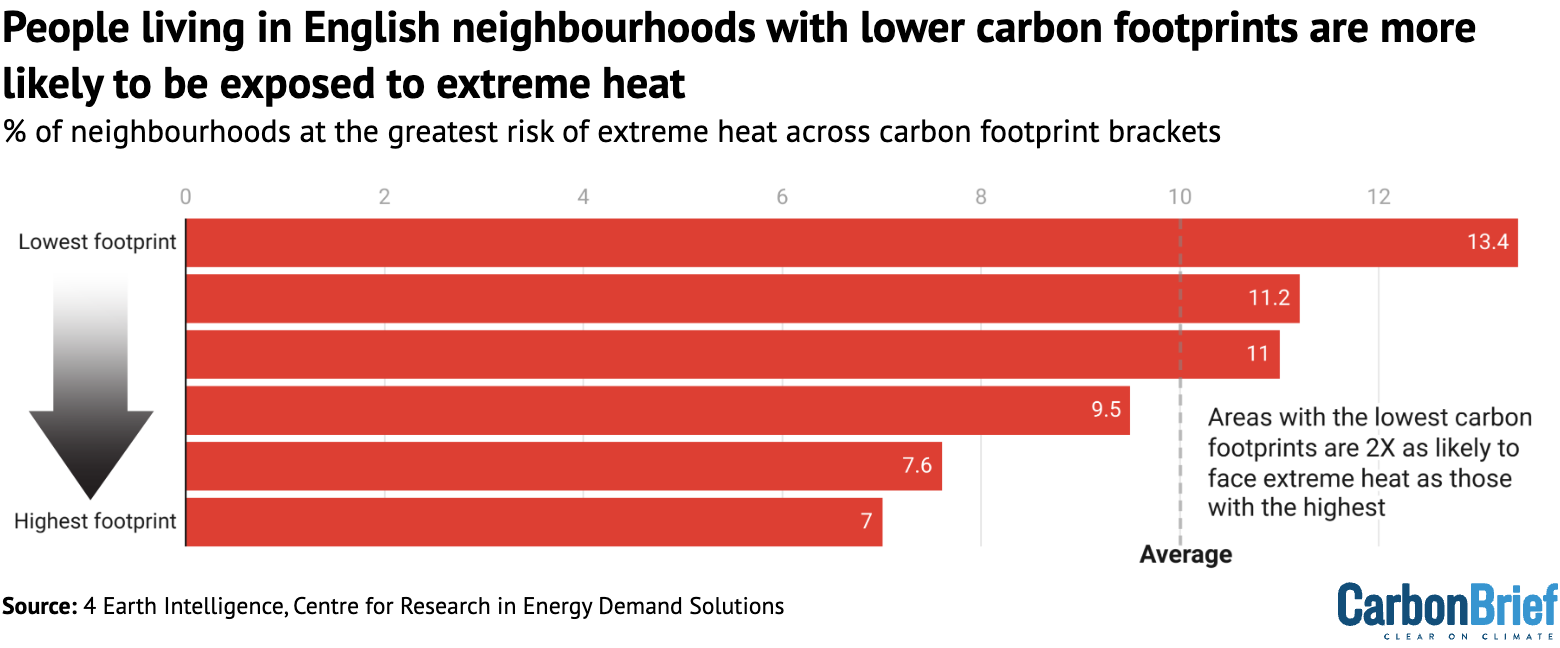
Neighbourhoods in England with lower carbon footprints are often in dense, urban areas, where people tend to be less reliant on cars and more likely to live in energy-efficient flats.
Areas with higher carbon footprints are commonly found in rural areas, where travelling by car can be a necessity due to limited public transport.
Also, particularly in south-east England, people in these rural neighbourhoods are often wealthier, meaning they spend more money on flights and other high-emitting luxuries.
Ethnicity and deprivation
Carbon Brief also analysed the heat threat facing deprived neighbourhoods in England and those that are home to more people of colour.
Information about how many people identify as black, Asian and other minority ethnicities in each neighbourhood is based on 2021 census data, via the Office for National Statistics.
As the chart below shows, there is a clear correlation between the number of people of colour living in a neighbourhood and the likelihood of it facing extreme heat during periods of hot weather.
The most ethnically diverse neighbourhoods – where roughly half or more of the population are people of colour – are 15 times more likely to have high heat hazard scores than the least ethnically diverse neighbourhoods, where almost everyone is white.
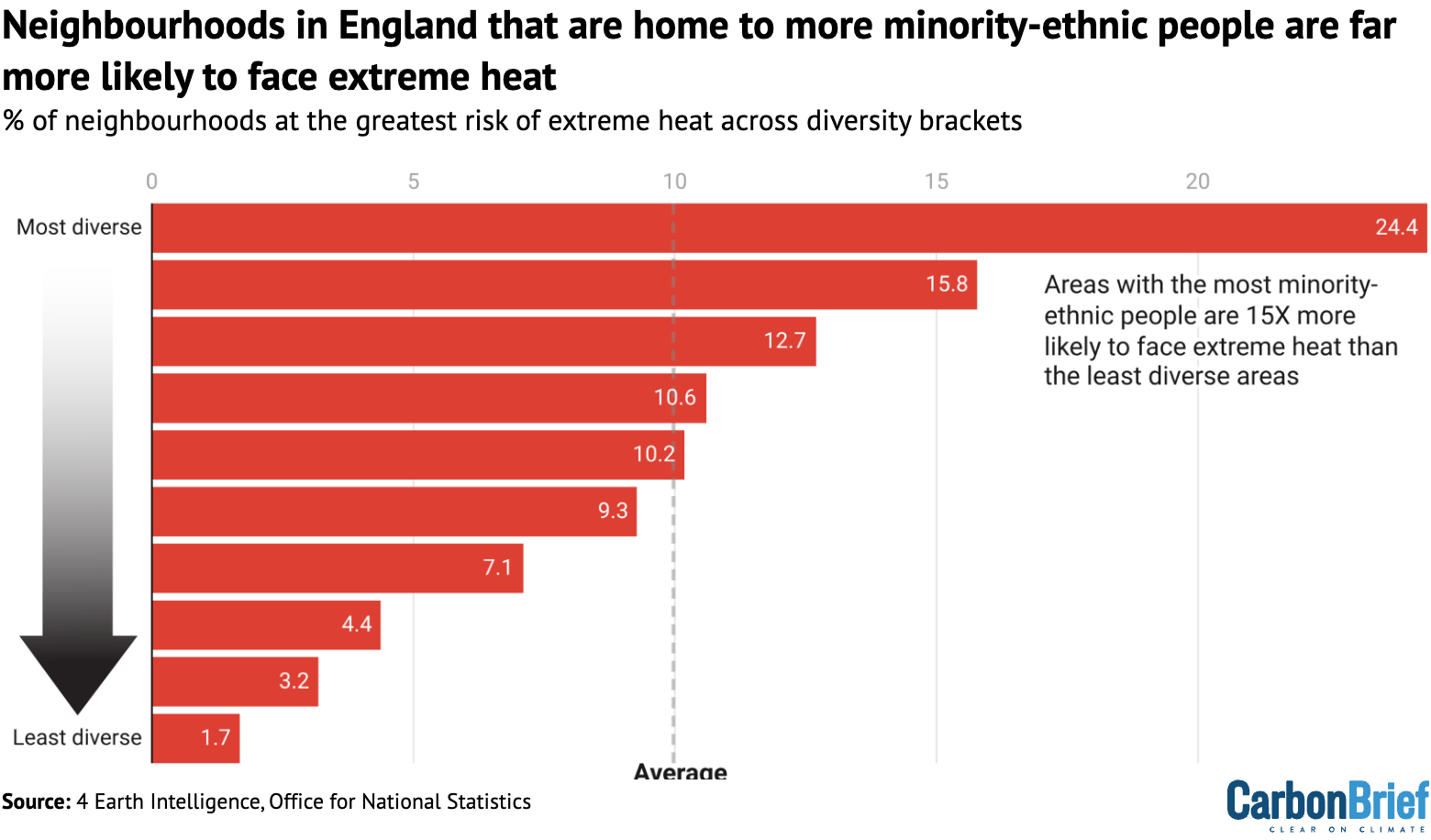
Among the most diverse areas are parts of Newham in east London, Saltley in Birmingham and Spinney Hills in Leicester, all of which are inner-city areas.
The least diverse neighbourhoods range from coastal parts of Redcar and Cleveland in North Yorkshire to the rural villages of south Somerset. None of England’s hottest 1% of neighbourhoods are in this bracket.
Additionally, Carbon Brief assessed the relationship between levels of poverty and heat risk, based on England’s indices of deprivation dataset. This covers several measures of deprivation, including income, employment and health.
People living in the most deprived English neighbourhoods are more than three times as likely to face high levels of heat hazard as those in the least deprived neighbourhoods, as shown in the figure below.
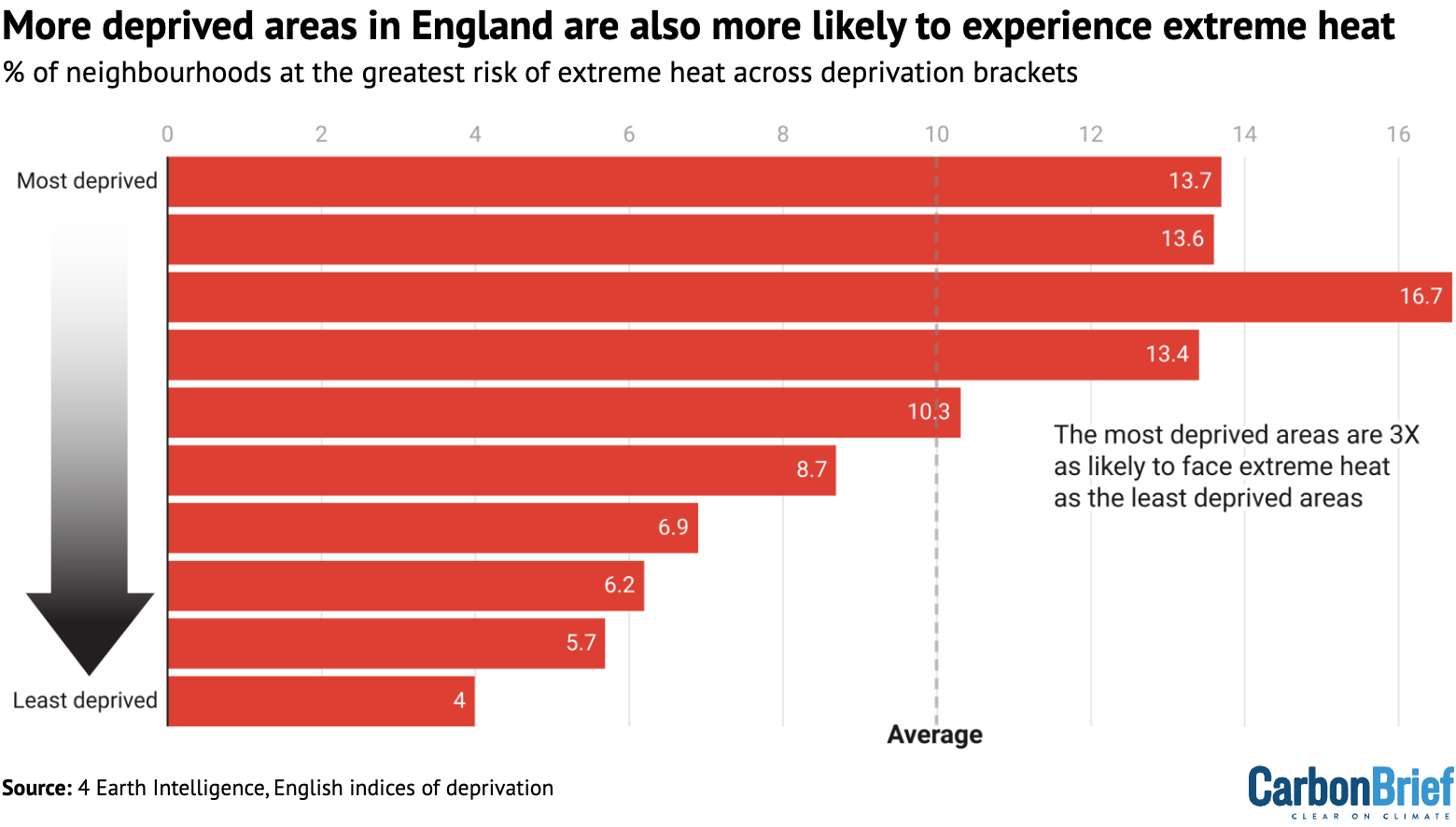
The correlation between poverty and extreme heat is less extreme than the one between heat exposure and ethnicity.
While many of England’s most deprived areas are in cities, they are also clustered in some rural and coastal areas – such as parts of Cornwall and Lincolnshire – which tend to be cooler.
Urban heat island
The key phenomenon captured by this analysis is the urban heat island effect. This describes how cities – and particularly areas with dense buildings, roads and stretches of concrete that absorb heat – tend to be hotter than the surrounding countryside.
Cities such as London, Manchester and Birmingham have reached temperatures up to 5C hotter than the surrounding areas in recent decades, due to this effect.
The diagram below shows how air flows circulate between rural and urban areas, forming “heat domes” over cities.
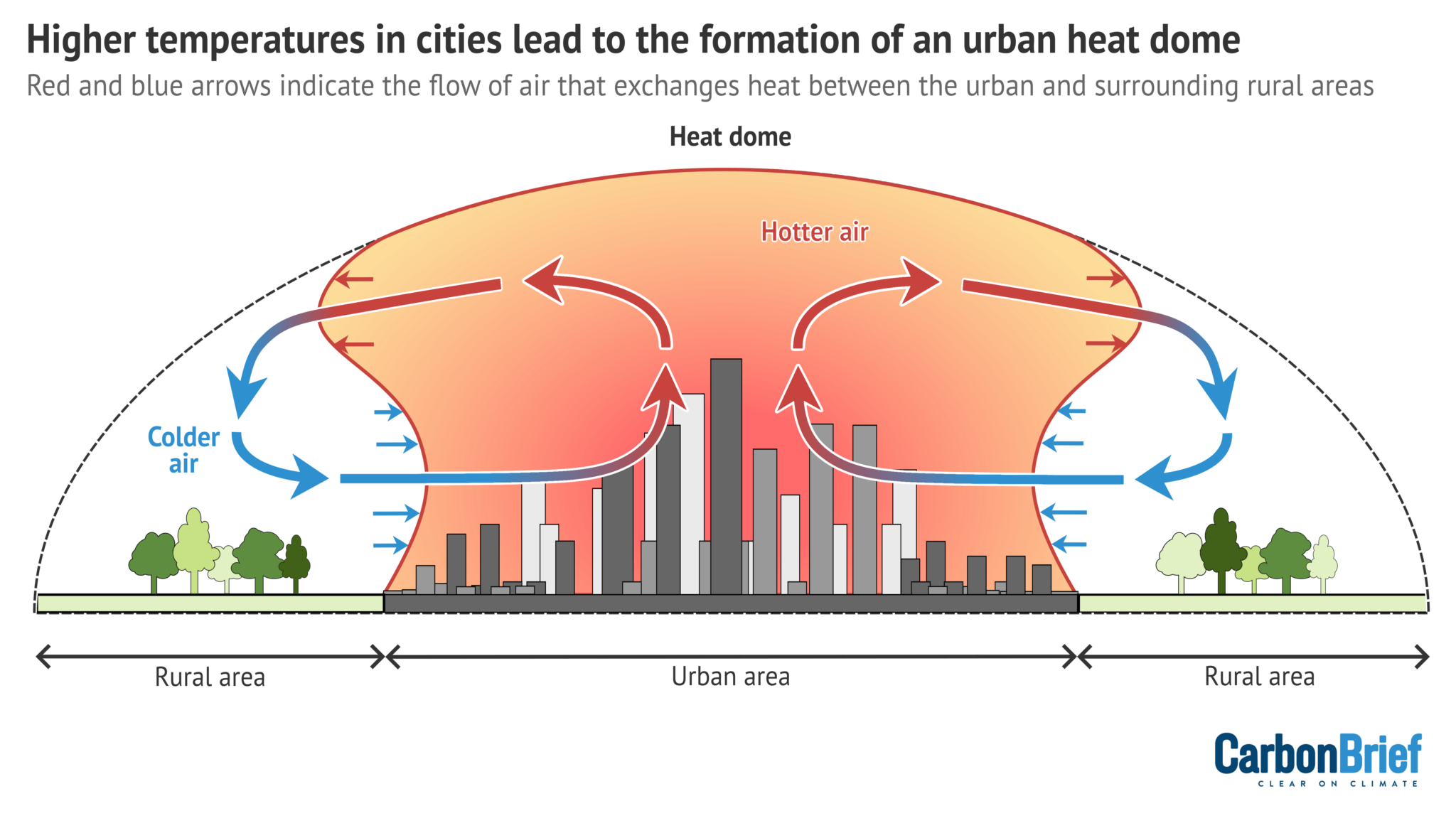
Inner-city areas in England are also home to many people facing high levels of deprivation, as well as large black and Asian communities. Many of these communities are therefore exposed to more dangerous temperatures due to the urban heat island effect.
Access to green spaces, even within cities, also influences exposure to the urban heat island effect. Research has shown how people in deprived areas and people of colour – particularly black people – are more likely to live in areas with less access to green spaces.
There is already extensive scientific literature that uses satellite data to demonstrate the urban heat island effect in cities and other locations.
A number of studies have also used this data to show how people of colour and those living in poverty are more exposed to extreme heat. Much of this research has come from the US, where historic housing inequalities have created stark patterns of segregation in many cities.
A project led by environmental policy researcher Dr Angel Hsu of the University of North Carolina-Chapel Hill shows how, globally, “cities are burdening lower-income populations with higher heat exposure”, as she tells Carbon Brief.
Given this, Hsu adds that “it’s not surprising to us to see similar disproportionate exposure patterns among UK neighbourhoods”.
Other researchers tell Carbon Brief that it is important to be wary of satellite data, as it does not precisely capture the air temperatures experienced in these neighbourhoods.
Dr Charles Simpson, who researches the health and economic impacts of climate change at University College London (UCL), notes:
“Satellite-measured surface temperature does not always correlate with the air temperature – what you are measuring includes a lot of road surfaces and rooftops. The air temperature is thought to be more directly relevant to people’s health and their cooling needs.”
Previous research has found that satellite data can therefore overestimate the urban heat island effect compared to data from weather stations.
These stations, however, are not widespread enough to allow comparisons with detailed neighbourhood data. They are particularly lacking in more deprived areas in England, potentially making measurements there less reliable.
Other scientists tell Carbon Brief that, in the absence of a comprehensive ground monitoring network, satellite measurements can serve as a stand-in to estimate heat exposure. Dr Chloe Brimicombe, an extreme-heat researcher based at the University of Graz, explains:
“Although it’s not a good indicator of perceived [temperature], it is a good indicator of what regions are most built up and have the environments that are most vulnerable to heat.”
‘Amplifying’ inequalities
There is a growing body of evidence gathered by activists, scientists and local governments around the UK revealing the unequal burden of climate change.
Dr Charles Ogunbode, an assistant professor of applied psychology at the University of Nottingham who specialises in how people experience climate change, tells Carbon Brief that this kind of data helps to clarify the links between climate change and inequalities:
“We can’t avoid dealing with the issue of social inequalities and climate change is just basically amplifying those things. It’s highlighting them, it’s revealing them. So whatever policies we put in place – be it in the health sector, be it in the climate sector – addressing those inequalities has to be an essential part of whatever those responses are.”
There are many factors influencing how people experience heat that are not captured in Carbon Brief’s analysis.
Previous work by researchers at the University of Manchester and Friends of the Earth has explored this issue, including an analysis of more than 40 indicators that could make neighbourhoods more “socially vulnerable” to heat.
This reveals similar outcomes, with people of colour and those contributing the least to climate change generally more vulnerable to its impacts.
One of the biggest factors that contributes to people’s exposure to heat extremes in the UK is the country’s housing stock, which is “not fit for the future”, according to the CCC.
UK homes have generally not been built for hotter conditions and poorer people are more likely to live in badly adapted housing. Those living in small homes, flats and social housing in England all “suffer significantly more overheating” during heatwaves, according to one study.
Dr Giorgos Petrou, a researcher in building physics modelling at UCL, tells Carbon Brief that it is also vital to consider whether households have the ability to adapt to climate change. “Amongst other factors, their capability will depend on their financial means and whether they own or rent their home,” he says.
Experts tell Carbon Brief that the government should act across its policy agenda to not only address extreme heat, but also support those who are most affected by it. This could involve expanding tree cover and renovating old social housing stock in at-risk communities.
Emma Howard Boyd, a former chair of the Environment Agency who also chaired the London Climate Resilience Review, tells Carbon Brief:
“I do think that with [the Labour] government focusing on house building and retrofit, this is a fantastic opportunity to get this right…For those communities that have had the least impact on the environment and climate change themselves.”
Methodology
This analysis collates several datasets that cover England at a neighbourhood level, with “neighbourhoods” defined as lower-layer super output areas (LSOAs). These are small statistical areas used by the UK government, covering populations of about 1,500-3,000 people. There are 33,755 LSOAs in England.
Data on vulnerability to heat comes from 4 Earth Intelligence (4EI), which analyses land surface temperature to generate “heat hazard” information at a 30m resolution. This detailed information has been converted into LSOAs by 4EI.
Heat hazard scores are calculated by 4EI, based on the likelihood that a given neighbourhood will experience high temperatures during hot weather, relative to the surrounding area.
Each score corresponds to a different percentile of English neighbourhoods. The bar below shows the percentage breakdown across all LSOAs in England.
The two hottest scores – those coloured in red – correspond to the 10% of English neighbourhoods that have higher heat hazard scores than the remaining 90%.

For simplicity, Carbon Brief’s analysis focuses on the red bars above, meaning neighbourhoods in either the top 90th-99th percentile or 99th percentile of heat hazard. (Neighbourhoods in the 90th-99th percentile have higher heat hazard scores than 90% of areas in England. Neighbourhoods in the 99th percentile have higher heat hazard scores than 99% of areas.)
It shows how these two scores are overrepresented in LSOAs that have lower carbon footprints, more diverse communities and higher levels of deprivation.
Carbon-footprint data is from the CREDS “place-based carbon calculator”, which estimates the average per-person carbon footprint for every LSOA in England. It accounts for emissions-producing activities ranging from electricity use to “consumption of goods and services”.
CREDS assigns the grades “A” to “F” (low carbon footprint to high carbon footprint) to neighbourhoods. Carbon Brief has based its carbon-footprint analysis on these grades.
LSOA-level data on black, Asian and other minority-ethnic populations comes from 2021 census data. English LSOAs were broken down into deciles, based on the percentage of the population that identified as non-white ethnicities.
The lowest decile covered the tenth of LSOAs with between 0 and 2% non-white minority-ethnic populations and the highest covered the tenth with more than 51%.
England’s indices of multiple deprivation dataset also includes LSOA-level information. It provides relative measures of deprivation for LSOAs in England, based on income, employment, education, health, crime, living environment and barriers to housing and services. Carbon Brief broke the LSOAs down into deciles based on the total deprivation scores, from the most deprived to the least deprived.
The post Analysis: England’s most ethnically diverse areas are 15 times more likely to face extreme heat appeared first on Carbon Brief.
Analysis: England’s most ethnically diverse areas are 15 times more likely to face extreme heat
Climate Change
Fossil-fuelled heat has caused tropical birds to decline by ‘up to 38%’ since 1950s
An uptick in heat extremes, driven by human-caused climate change, has caused tropical bird populations to decline by up to 38% since the 1950s, according to a first-of-its-kind analysis.
The study combines ecological and climate attribution techniques to trace the fingerprint of fossil-fuelled climate change on declining wildlife populations.
It shows that an increase in heat extremes driven by climate change has caused tropical bird populations to decline by 25-38% in the period 1950-2020, when compared to a world without warming.
The findings could help to explain why tropical bird numbers have declined even in pristine rainforests, a phenomenon that previously mystified biologists, the scientists say.
‘Chance encounter’
Over the past few decades, an emerging field of science known as “climate attribution” has used a standardised set of techniques to trace the fingerprint of human-caused warming on different elements of the climate system, ranging from worsening extreme weather events to episodes of glacier melt.
The new research, published in Nature Ecology and Evolution, is the first to use climate attribution techniques to detect the fingerprint of climate change on declining wildlife populations.
The study came about following a “chance encounter” between lead author Dr Maximilian Kotz, a climate scientist at the Barcelona Supercomputing Center in Spain, and his co-authors, who are biodiversity experts at the University of Queensland in Australia, while Kotz was completing a research stay in Australia.
Kotz says to Carbon Brief:
“As far as we are aware, this is the first animal climate attribution study.”
The researchers decided to focus on birds, rather than other animal species, as they have the “best available data, covering a good range of different species and geographies”, he adds.
Heat extremes
The authors examine how an intensification of heat extremes could have impacted bird populations, while controlling for other factors known to affect wildlife, including average temperature increase and human pressures, such as land-use change.
Episodes of extreme heat are known to have an immediate and long-lasting impact on birds, Kotz says:
“High temperature extremes can induce direct mortality in bird populations due to hyperthermia and dehydration. Even when they don’t [kill birds immediately], there’s evidence that this can then affect body condition which, in turn, affects breeding behaviour and success.”
Using statistical techniques, the scientists first analyse historical records to identify how bird populations have responded to fluctuations in climate, including heat extremes, over 1950-2020.
The team sourced global data on bird populations from the database that underlies the Living Planet Index, put together by the environmental charity WWF. They note it is the most comprehensive database available, but still has “clear geographic biases”, with global north regions better represented than those in the global south.
They use an attribution framework to estimate the extent to which human-caused warming influenced the changes in heat extremes observed in that time period, then calculate the impact of these climate-change-driven heat extremes on bird population changes from 1950-2020.
(The authors defined “heat extremes” as temperatures within the top 1% of daily temperatures over 1940-70, with data taken from ERA5, a global reanalysis dataset, which combines data from weather stations, satellites and model output.)
To understand how this would compare to a world without climate change, the researchers subtract this impact from the historical records.
Comparing their results to the counterfactual world without climate change allowed them to quantify how bird populations have changed as a result of human-driven increases in heat extremes.
Mapped
The research finds that human-driven heat extremes have had “strong negative impacts” on bird population numbers, with those residing at lower latitudes being the most affected.
The map below shows the percentage change in bird population abundance attributed to heat extremes over 1950-2018, when compared to a world without climate change.
On the map, dark red shows large decreases in population abundance, while light blue indicates small increases. (Abundance refers to the number of individual animals in a given population.)
The research finds that birds in the tropics have experienced the largest declines attributable to heat extremes.
It concludes that an uptick in heat extremes has caused tropical bird abundance levels to decline by 25-38% in the period 1950-2020, when compared to a world without warming.
The range in the size of that impact reflects the results of different models, which each use slightly different techniques to simulate changes to bird populations, Kotz says.
Tropical turmoil
In their paper, the authors note that their finding that tropical birds have experienced the most substantial declines are “consistent” with other studies indicating that “birds in these regions may be closer to the thermal limits at which impacts start to occur”.
They add that the findings are “particularly pertinent, given recent documentation of declining tropical bird populations, even in undisturbed habitats”.
One previous study found that in a “relatively undisturbed” part of the Amazon rainforest, bird abundance declined by more than 50% from 2003 to 2022. Similar results were found in a forest in Panama.
The authors of the new study say:
“The source of such declines have been noted as unknown, yet they are of a similar order of magnitude to our estimates of the impacts of intensified heat extremes.”
Their results suggest that “in tropical realms, climate change impacts on bird populations may already be comparable to land pressures that lead to habitat destruction and degradation”, the authors say.
This has “potential ramifications” for commonly proposed conservation strategies, such as increasing the amount of land in the the tropics that is protected for nature, they continue:
“While we do not disagree that these strategies are necessary for abating tropical habitat loss…our research shows there is now an additional urgent need to investigate strategies that can allow for the persistence of tropical species that are vulnerable to heat extremes.”
In some parts of the world, scientists and conservationists are looking into how to protect wildlife from more intense and frequent climate extremes, Kotz tells Carbon Brief.
He references one project in Australia which is working to protect threatened wildlife following periods of extreme heat, drought and bushfires.
Informing forecasts
As well as shedding light on what could be behind the rapid decline of birds in the tropics, the findings also underscore the importance of examining changes in climate extremes, rather than just annual global temperature rise, says Prof Alex Pigot, a biodiversity scientist at University College London (UCL), who was not involved in the research. He tells Carbon Brief:
“Most of the models that have been used to make projections of risk to biodiversity under future climate change use long-term climate averages and so the results of this study suggest that our existing risk assessments could be missing these critical impacts of climate change.
“We urgently need to address this and develop early warning systems to be able to anticipate in advance where and when extreme heatwaves and droughts are likely to impact populations – and also rapidly scale up our monitoring of species and ecosystems so that we can reliably detect these effects and feed this information back into our models to refine our future projections for biodiversity.”
Dr Peter Soroye, a biodiversity scientist at the Wildlife Conservation Society Canada, who was also not involved in the research, agrees:
“It’s not just that the climate is getting gradually warmer every year with climate change, it’s that climate change is also driving increasingly frequent and severe extreme temperature events that are putting wildlife at risk.
“As we more fully understand the importance of extremes, it seems increasingly important to consider them when we model or project changes in biodiversity over time.”
The post Fossil-fuelled heat has caused tropical birds to decline by ‘up to 38%’ since 1950s appeared first on Carbon Brief.
Fossil-fuelled heat has caused tropical birds to decline by ‘up to 38%’ since 1950s
-
Climate Change2 years ago
Spanish-language misinformation on renewable energy spreads online, report shows
-
Climate Change Videos2 years ago
The toxic gas flares fuelling Nigeria’s climate change – BBC News
-

 Greenhouse Gases1 year ago
Greenhouse Gases1 year ago嘉宾来稿:满足中国增长的用电需求 光伏加储能“比新建煤电更实惠”
-

 Climate Change1 year ago
Climate Change1 year ago嘉宾来稿:满足中国增长的用电需求 光伏加储能“比新建煤电更实惠”
-

 Carbon Footprint1 year ago
Carbon Footprint1 year agoUS SEC’s Climate Disclosure Rules Spur Renewed Interest in Carbon Credits
-
Climate Change2 years ago
Why airlines are perfect targets for anti-greenwashing legal action
-
Climate Change Videos2 years ago
The toxic gas flares fuelling Nigeria’s climate change – BBC News
-
Climate Change2 years ago
Some firms unaware of England’s new single-use plastic ban






